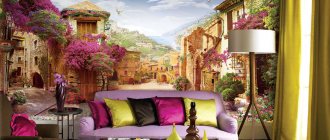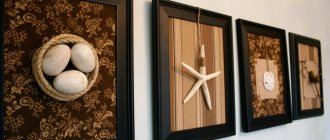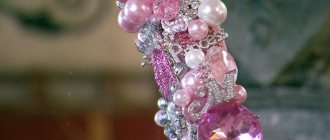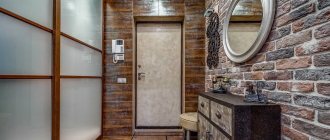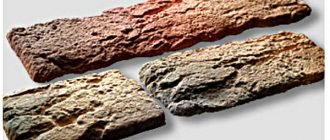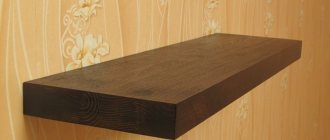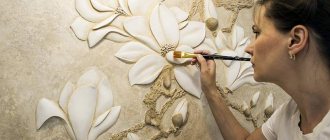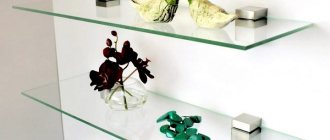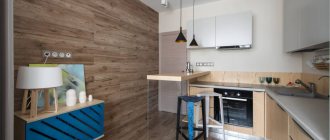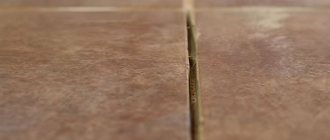Repairs carried out quite often leave walls in the apartment that need to be filled and decorated with something. Designers offer many options, and one of them is a fresco on the wall. Used since ancient times, and now experiencing a “new revival,” this option for interior decoration is becoming increasingly popular.
So what is a fresco? This is a drawing made on wet plaster. Over time it dries and the image becomes part of the wall. Previously, palaces, temples and rich houses were decorated this way. Many of the greatest artists and icon painters made frescoes.
However, having survived the peak of development during the Renaissance by the 20th century, frescoes lost their relevance. Until now, in the modern world, they have not attracted the attention of designers.
True, it is worth noting that the concept of fresco in the modern sense has become broader. This is due to the development of new technologies in construction, finishing, and paints.
Fresco on canvas
It is also not a cheap or simple technology. Handmade canvas is coated with special compounds and paints based on natural pigments.
Artificial aging is used. The fresco is also covered with special protective agents, and in general this type of fresco requires regular and constant care.
Application methods
The method of completing the work depends entirely on your abilities, whether you draw everything by hand or using a stencil. But regardless of this, you will need to acquire the following tool:
- Acrylic paints.
- Brush with artificial bristles.
- Brush with natural bristles.
- Soft, clean cloth.
- Clear nail polish.
- Wide lead.
- Sharp pencil.
- Washcloth.
Depending on the design you choose, choose a brush of the desired thickness.
Let's look at the features of applying a fresco using two different methods.
Freehand drawing
Drawing should begin from top to bottom. In this case, you will not get dirty with paint and spoil the drawing. First of all, draw the large elements, and then the small ones. In some cases, it is better to work on small details after the main part of the drawing has dried.
Some people decide to create a cracked effect by applying craquelure paint. To give the design an antique look, use silver or gold-plated powder. Remember, craquelure is applied to completely dry paint, and powder is applied to slightly hardened paint.
When the surface is dry, you can use a washcloth to remove any excess. Finally, all you have to do is varnish the entire surface. There is often a need to apply several layers of varnish. Everything will depend on the desired effect.
Using a slate stencil
The principles of applying paint and varnish remain unchanged compared to the previous method. Therefore, there is not too much difference in this work. The key difference is the stencil application.
To apply a fresco using this method, you need to paint over the sketch with a wide stylus. Next, attach the sketch with the painted side to the wall and trace the contours with a pencil. In this case, you can accidentally scratch the sketch during the process. It's not scary. This can give some individuality to a particular drawing.
This work is best done by two people, one holding the stencil and the other tracing the outline.
You can learn how to apply a fresco using a stencil from the video:
Simple Application Methods
There are stencils that are made of thin paper. It is coated with a special glue on the reverse side and applied to the wall. When the paper has dried, the design you have in mind is applied to it. Another option for applying a fresco is even simpler. A special canvas with a pattern is glued to the wall, like wallpaper. It is glued with non-woven glue. When the canvas is dry, all that remains is to level it and coat the surface with varnish.
You can learn how to simply apply a fresco through a thin paper stencil from the following video:
Self-adhesive mural
This mural is very similar to textured wallpaper or wall mural. A layer of fine river sand is applied to its base, imitating plaster. It is very easy to glue, which is its big advantage.
However, its main advantage is a very rich selection of designs that you can select yourself and print on a special printer. The disadvantages include the fact that this fresco is very thin. Therefore, it can only be glued to a leveled surface.
Reviews
- Irina
Moscow
27.05.2021
I express my deep gratitude to the managers for the very good organization of work with clients, starting with a very clear website and ending with the excellent execution of the frescoes! But the most important thing is that there is an excellent team of professional managers! Tatiana Shchebruk worked with us. Many thanks to her for her help and advice! We got a wonderful result, I couldn’t be happier!!!
- Elena
Saransk
20.05.2021
The fresco came out PERFECTLY!!! THE BEAUTY is indescribable! I REALLY LOVED IT!!!!
- Larisa Prokofievna Krymova
Moscow
19.05.2021
I must say that the fresco in the house is a fairy tale. This decorates the interior... I am grateful for the plot and execution. Thank you!
- Marina
Moscow
08.05.2021
Many thanks to the First Atelier, represented by Ekaterina, for the fresco! The drawing had to be processed and finalized, but it turned out exactly as I wanted. The order arrived very quickly and without prepayment. The quality is excellent!
- Tatiana
Moscow
07.05.2021
Thank you for your order, everything is great!!! Special thanks to Tatyana Shcherbuk, everything was on time, the quality is excellent, I can’t even complain...delivery ahead of schedule, everyone learn from Tatyana Shcherbuk how to work!!!! THANK YOU!!! We look at the fresco and understand how to live well, and living well is even better!!!!!!!!
We have a total of 632 reviews
Non-woven fresco
The fresco on a non-woven base is very easy to glue yourself using glue for non-woven wallpaper. After this, the surface is coated with varnish, which makes it much more durable.
In addition, the presence of a variety of designs and decorative elements allows it to be used in a wide variety of interiors. Especially often used over large areas.
How to do it: step by step instructions
So, we suggest you follow step by step how to do this work yourself:
- At the first stage, the wall is prepared, which includes removing the old coating and applying a new one.
- Before directly applying the drawing, the wall should be primed.
- Next you need to make markings. For example, let's take a fresco consisting of three compositions. Therefore, using a level, draw 3 rectangles. In this case, 1 rectangle is equal to the size of the picture, 2 to the mat, and 3 to the baguette.
- When the marking is completed, the contours of the drawing must be covered with masking tape. Next, apply the plaster in a thin layer.
- At the next stage, prepare the rice paper on which the image is printed. To make the image look textured and natural, tear off its ends.
- When the putty has dried, you can glue the rice paper, smoothing it with a rubber roller. It should be smoothed from the middle to the side. The drawing itself is glued using PVA mixed with water.
- The drawing and its individual elements are glued in the required sequence.
- Now you putty the small frame of the passe-partout. Next, tint the frame in the desired color. To prevent the paint consistency from being too thick, add a little water to it and stir until smooth.
- It is necessary to paint the mat so that transitions are not visible. And if you want to make smooth transitions from one color to another, then the brush should be thoroughly washed before using another color.
- Without waiting for complete drying, sand all the resulting textures of the fresco.
- Now you can leave the drawing to dry completely.
- Once everything is dry, take some grit sandpaper and sand the surface to make it smooth. After this, wipe the fresco with a damp cloth. You should act carefully, as you can very easily damage the drawing.
At the end of all the work, the surface of the wall remains to be painted with liquid acrylic with a wide brush, and a matte varnish is applied to the drawing in two layers. You decorate the entire resulting composition with a baguette.
This is the sequence in which the fresco is completed. This technology will allow you to create a unique look for the entire interior.
Flexible plaster fresco
A very popular type of fresco. Thanks to natural dyes, it is very similar to the classical form in beauty and technology. For its production, a special elastic plaster is used.
It takes a very long time to dry and harden, which increases the working time significantly. It is so convenient that people who have at least some skills in finishing and drawing make them themselves.
Historical reference
In the old days, frescoes were used to decorate the walls of palaces and temples. Many famous artists and icon painters became famous for their works in this technique. Among them are Michelangelo, Raphael, Leonardo da Vinci, Diego Riviera, icon painter Andrei Rublev and painter Dionysius.
Famous fresco by Michelangelo
Through the centuries, the frescoes in the Sistine Chapel, the Assumption Cathedral, the Church of the Transfiguration and the Villa of the Mysteries fascinate and delight. In modern interiors, frescoes are often used to decorate the walls of mansions and restaurants, and are used in homes as decor.
Fresco on a rigid base
To make this fresco, a rigid base (wood, plastic, ceramics) is used. It is easy to apply various effects and techniques to such coatings (cracks, imitation chips, aging).
Well, the most important thing is the ability to create volume and depth of the image. True, such frescoes are very massive and, as a result, are made in small areas.
Materials and tools.
- Basis for the fresco (canvas, plywood, chipboard, piece of wall).
- Soil (selected for a specific surface).
- A fragment of rice paper, decoupage card or laser print with a motif for a mural.
- Putty for base coat.
- Structural paste for relief coating.
- Craquelure paste (if desired).
- Acrylic paint Gold.
- Acrylic paints to match the color palette of the image.
- Construction acrylic paint. White.
- Water-based bitumen (or paint diluted with water to a liquid state).
- Synthetic brush cat tongue (convenient for painting).
Read more about materials and tools for creating a mural here .
Thematic component of the frescoes
Modern technologies make it possible to use a wide variety of themes and styles in fresco images. However, when choosing a pattern, it is still necessary to take into account the features of the room and the general appearance of the apartment. The design of the wall mural should be appropriate.
- DIY artificial flowers - the best original home interior design ideas
Volumetric paper flowers - diagrams, templates, decor options and DIY decorations
Free Melbet promo code
It is difficult to single out any particularly popular styles of wall frescoes. Their variety is very great: classic, baroque, kitsch, minimalism, etc. It all depends on the desire of the owner. The main thing is that the theme of the fresco is combined and merges with the overall interior. Maintain harmony.
For living rooms, the most common are classic themes, since it is the center of the house (apartment). But in the bedroom it would be better to have something calming and soothing, for example, flowers, seascapes. By the way, a great idea for a mural on the wall is a photo from your own vacation.
The children's room is decorated with simple and understandable things for a child: fairy-tale landscapes, cartoon or comic book characters.
When making a fresco in the bathroom or kitchen, it is also necessary to take into account such criteria as practicality, moisture resistance, and resistance to temperature changes.
Notes on the work.
- The motif for the fresco should resemble antiquity. As a rule, these are religious motifs or paintings depicting the life and color of the area in which the frescoes were created. Bright colors and modern motifs are not suitable for simulating an ancient fresco. Read more about choosing a motif and color palette here .
- Latex putty is suitable for work only if there is an idea from the author. This is a chalky putty, it can crack when it dries, it has a lot of sandy inclusions. It is not very suitable for working with thin reliefs.
- There is no need to apply a thick layer of relief under the image, because... it can “interrupt” the image.
- The putty should be applied with a palette knife from the center to the edges. You should not create a high relief, since a fresco is, in fact, a piece of a wall and the relief should convey the texture of the old wall.
- PVA glue makes the putty more liquid and flexible. This helps create softer reliefs and in some cases can replace the absence of expensive structural pastes.
- To master the techniques and secrets of imitating a fresco in decoupage, it is advisable to undergo training from accomplished masters who practice creating frescoes.
Natalya Kolosova.
Imitation of an ancient fresco. PS: the master class is taken from open sources.
Photo of murals on the wall
All that remains is to choose a place and think about what to place in the center
The size of the installation depends only on your imagination and the size of the old curtain. A little patience, scrupulousness, and joint work will help pass away more than one evening. A sheet of hardboard, an old rag, a couple of brushes, half a liter of varnish, and you can hang the finished panel on the wall.
The beauty of such interior decoration is not only that the fresco was made with your own hands, it can be hung anywhere. It is glued to the wall with four points, you can remove it at any time, but why? A great interior touch made from materials that could have been thrown away.
Moldings for decorating frescoes
Moldings for decorating frescoes
Yes, I had to buy moldings, varnish, a couple of brushes and a jar of PVA. But you must admit, 800 rubles were worth it to have an elegant fresco on the wall, made with your own hands, with the help of your husband, or a man who was at hand.
From the manufacturers' point of view, this is a very high-quality fresco:
- Fabric base, impregnated and wet applied to the base;
- Relief providing play of light and shadow;
- An interesting perimeter, gravitating towards classics and baroque.
Why pay more for something you can do yourself and according to your preferences?
The finished result
The finished result
The most famous frescoes were created by one person, and survived all the creators. What you see in the photo will also outlive those who took it. There is one difference from the classics - this fresco is portable.
Briefly about the main thing
The ancient art of painting on wet plaster remains a popular way to decorate modern rooms. Drawings are applied using a stencil or painted with a brush using water-based paints.
The painting is carried out in several stages. First, prepare the surface: it is cleaned, roughened and primed. Then several (from three to seven) layers of plaster are applied with intermediate drying of each.
An outline is applied to the last layer, then the image is drawn with paints. The performer is required not only to have artistic talent, but also to be able to work quickly in order to complete the area before the plaster dries.
Ratings 0
